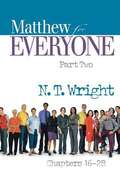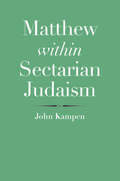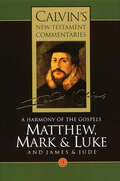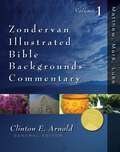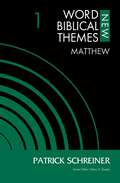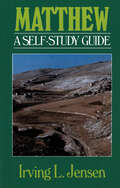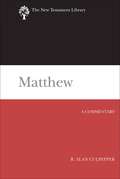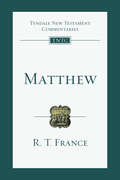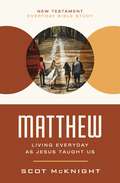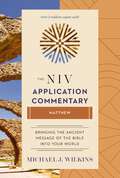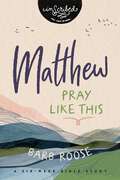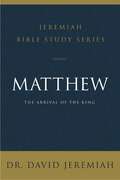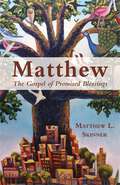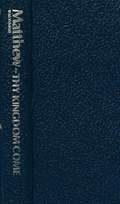- Table View
- List View
Matthew for Everyone, Part 2: Chapters 16-28 (The New Testament for Everyone)
by N. T. WrightTom Wright's eye-opening comments on the Gospel of Matthew and what it might mean for us are combined, passage-by-passage, with his fresh translation of the Bible text. Making use of his true scholar's understanding, yet writing in an approachable and anecdotal style, Wright captures the urgency and excitement of Matthew's Gospel in a way few writers have.Tom Wright has undertaken a tremendous task: to provide guides to all the books of the New Testament, and to include in them his own translation of the entire text. Each short passage is followed by a highly readable discussion with background information, useful explanations and suggestions, and thoughts as to how the text can be relevant to our lives today. A glossary is included at the back of the book. The series is suitable for group study, personal study, or daily devotions.
Matthew within Sectarian Judaism: An Examination (The Anchor Yale Bible Reference Library)
by John KampenA renowned scholar of the Dead Sea Scrolls argues for reading the Gospel of Matthew as the product of a Jewish sect In this masterful study of what has long been considered the “most Jewish” gospel, John Kampen deftly argues that the gospel of Matthew advocates for a distinctive Jewish sectarianism, rooted in the Jesus movement. He maintains that the writer of Matthew produced the work within an early Jewish sect, and its narrative contains a biography of Jesus which can be used as a model for the development of a sectarian Judaism in Lower Syria, perhaps Galilee, toward the conclusion of the first century CE. Rather than viewing the gospel of Matthew as a Jewish-Christian hybrid, Kampen considers it a Jewish composition that originated among the later followers of Jesus a generation or so after the disciples. This method of viewing the work allows readers to understand what it might have meant for members of a Jesus movement to promote their understanding of Jewish history and law that would sustain Jewish life at the end of the first century.
Matthew's Story (Jesus Chronicles #4)
by Tim Lahaye Jerry B. JenkinsThe fourth installment in the Jesus Chronicles, from the bestselling author of the Left Behind series. This story in the Jesus Chronicles depicts the life of the most unlikely of apostles-a sinner turned saint-and his time with the Lord. <P><P>With Matthew, readers walk alongside Jesus as He gives the Sermon on the Mount, performs the miracles of healing the sick and raising the dead, contemplates His fate at the Last Supper and in the Garden of Gethsemane, is crucified, and most important, resurrected. <P>Thrilling and uplifting, Matthew's Story shows how the true Messiah changed the life of one man, and forever altered the course of history.
Matthew, Mark, & Luke: A Harmony of the Gospels (Calvin’s New Testament Commentaries (CNTC))
by John CalvinThis volume is one of twelve classic commentaries by John Calvin, theologian par excellence of the Reformation, whose expositions of Scripture remain as relevant as ever. Edited by David W. Torrance and Thomas F. Torrance, these twelve commentaries on the New Testament bring Calvin's authoritative voice to life in clear contemporary English. The translations all strive to retain the close coherence of Calvin's ideas and characteristic images while remaining faithful to the Latin text — doing full justice to the Reformer's qualities as one of history's finest expositors of the Word of God.
Matthew, Mark, & Luke: A Harmony of the Gospels (Calvin’s New Testament Commentaries (CNTC))
by John CalvinThis is a print on demand book and is therefore non- returnable. This volume is one of twelve classic commentaries by John Calvin, theologian par excellence of the Reformation, whose expositions of Scripture remain as relevant as ever. Edited by David W. Torrance and Thomas F. Torrance, these twelve commentaries on the New Testament bring Calvin's authoritative voice to life in clear contemporary English. The translations all strive to retain the close coherence of Calvin's ideas and characteristic images while remaining faithful to the Latin text — doing full justice to the Reformer's qualities as one of history's finest expositors of the Word of God.
Matthew, Mark, Luke: Volume One (Zondervan Illustrated Bible Backgrounds Commentary)
by Clinton E. ArnoldDiscover · How the springs at Hierapolis help us understand why Jesus described the church at Laodicea as “lukewarm” · The background and circumstances of certificates of divorce in Judaism · How Jewish dietary laws provided a powerful metaphor for God’s acceptance of the Gentiles Brimming with lavish, full-color photos and graphics, the Zondervan Illustrated Bible Backgrounds Commentary walks you verse by verse through all the books of the New Testament. It’s like slipping on a set of glasses that lets you read the Bible through the eyes of a first-century reader! Discoveries await you that will snap the world of the New Testament into gripping immediacy. Things that seem mystifying, puzzling, or obscure will take on tremendous meaning when you view them in their ancient context. You’ll deepen your understanding of the teachings of Jesus. You’ll discover the close, sometimes startling interplay between God’s kingdom and the practical affairs of the church. Best of all, you’ll gain a deepened awareness of the Bible’s relevance for your life. Written in a clear, engaging style, this beautiful set provides a new and accessible approach that more technical expository and exegetical commentaries don’t offer. It features: · Commentary based on relevant papyri, inscriptions, archaeological discoveries, and studies of Judaism, Roman culture, Hellenism, and other features of the world of the New Testament · Hundreds of full-color photographs, color illustrations, and line drawings · Copious maps, charts, and timelines · Sidebar articles and insights · “Reflections” on the Bible’s relevance for 21st-century living Written by leading evangelical contributors: Clinton E. Arnold (Ph.D., University of Aberdeen), General Editor S. M. Baugh (Ph.D., University of California, Irvine) Peter H. Davids (Ph.D., University of Manchester) David E. Garland (Ph.D., Southern Baptist Theological Seminary) David W. J. Gill (D.Phil., University of Oxford) George H. Guthrie (Ph.D., Southwestern Baptist Theological Seminary) Moyer V. Hubbard (D.Phil., University of Oxford) Andreas J. Köstenberger (Ph.D., Trinity Evangelical Divinity School) Ralph P. Martin (Ph.D., University of London, King’s College) Douglas J. Moo (Ph.D., University of St. Andrews) Mark L. Strauss (Ph.D., University of Aberdeen) Frank Thielman (Ph.D., Duke University) Jeffrey A. D. Weima (Ph.D., University of Toronto) Michael J. Wilkins (Ph.D., Fuller Theological Seminary) Mark W. Wilson (D.Litt. et Phil., University of South Africa) Julie L. Wu (Ph.D., Fuller Theological Seminary) Robert W. Yarbrough (Ph.D., University of Aberdeen) Zondervan Illustrated Bible Backgrounds Commentary includes Matthew, Mark, Luke (Volume One) John, Acts (Volume Two) Romans to Philemon (Volume Three) Hebrews to Revelation (Volume Four)
Matthew, Volume 1 (New Word Biblical Themes: New Testament)
by Patrick SchreinerVolumes in New Word Biblical Themes: New Testament series offer short, accessible studies of the key themes of each book of the New Testament.Each volume offers an introduction to the book, a brief exposition of the text with its basic background and a survey of its contents, an overview of its themes, and a deeper look at 3-5 key themes for understanding the book and for preaching and teaching.
Matthew- Teach Yourself the Bible Series: The Gospel of God's King (Teach Yourself the Bible)
by Keith L. BrooksMatthew's gospel is the bridge between Judaism and Christianity, presenting Jesus as the Messiah and mediator of the new covenant. Study the exciting changes that occur as Christian law replaces Levitical law, as the Lord's Supper replaces the Passover, and as the high priesthood of Jesus Christ replaces the old Aaronic priesthood.The Teach Yourself the Bible series is one of the best New Testament studies you will find anywhere. Each book in the series is packed full of valuable questions on individual chapters of the Bible, check-ups to test your grasp of biblical truths, and usable suggestions for group study.Grow in your knowledge of God through each New Testament book, then go on to study six aspects of Christianity essential for all believers: doctrine, prayer, eternal life, prophecy, Christian character, and Bible study.Strengthen your relationship with the living God with all twenty-five books of the Teach Yourself the Bible Series. Each volume is a timeless, yet practical, study of the Word of God.
Matthew: A Blackaby Bible Study Series (Encounters with God)
by Henry BlackabyIntended as companions to the Blackaby Study Bible, these guides also stand alone as a complete study of a book of the Bible.The lessons include: Leader's Notes7 studies based on reference materials included in the Blackaby Study BibleAn explanation and interpretation of Scripture A story that illustrates the passage in focus Other Bible verses related to the theme Questions for reflection Suggestions for application in everyday life
Matthew: A Commentary
by R. Alan CulpepperIn this new critical commentary for the New Testament Library series, R. Alan Culpepper sets the Gospel of Matthew in the context of the competing Jewish and early Christian voices of the first century, bringing greater clarity to Matthew's own proclamation of the gospel and inviting readers to give up perhaps long-held assumptions about the book. In Culpepper’s treatment, Matthew emerges as a Gospel for a Jewish community, distinguishing itself from the Pharisees on one side and other early Christian traditions and leaders, especially Paul and his followers, on the other side. In this framework, Matthew calls his community to faithful observance of the law, a law-observant mission to both Jews and Gentiles, and repentance and the practice of forgiving in preparation for the coming judgment. Accordingly, Matthew takes readers back to an early period, before the separation of Jewish Christians from the synagogues. By taking seriously Matthew’s Jewishness, this volume also enables readers to hear the historical Jesus more clearly. Excursuses on Matthew’s social setting include Jesus as healer, Sabbath observance, Roman taxation, the Pharisees, the tithes, ancient weddings, and the Sanhedrin, as well as many shorter units on Second Temple Judaism, synagogues, and first-century Galilean society. The New Testament Library series offers authoritative commentary on every book and major aspect of the New Testament, providing fresh translations based on the best available ancient manuscripts, critical portrayals of the historical world in which the books were created, careful attention to their literary design, and a theologically perceptive exposition of the biblical text. The contributors are scholars of international standing. The editorial board consists of C. Clifton Black, Princeton Theological Seminary; John T. Carroll, Union Presbyterian Seminary; and Susan E. Hylen, Candler School of Theology, Emory University.
Matthew: A Commentary, Volume 1
by Frederick Dale BrunerRecognized as a masterly commentary when it first appeared, Frederick Dale Bruner's study of Matthew is now available as a greatly revised and expanded two-volume work -- the result of seven years of careful refinement, enrichment, and updating.Through this commentary, crafted especially for teachers, pastors, and Bible students, Bruner aims "to help God's people love what Matthew's Gospel says." Bruner's work is at once broadly historical and deeply theological. It is historical in drawing extensively on great church teachers through the centuries and on the classical Christian creeds and confessions. It is theological in that it unpacks the doctrines in each passage, chapter, and section of the Gospel. Consciously attempting to bridge past and present, Bruner asks both what Matthew's Gospel said to its first hearers and what it says to readers today. As a result, his commentary is profoundly relevant to contemporary congregations and to those who guide them.Bruner's commentary is replete with lively, verse-by-verse discussion of Matthew's text. While each chapter expounds a specific topic or doctrine, the book's format consists of a vivid, original translation of the text followed by faithful exegesis and critical analysis, a survey of historical commentary on the text, and current applications of the text or theme under study. In this revision Bruner continues to draw on the best in modern scholarship -- including recent work by W. D. Davies and Dale C. Allison Jr., by Ulrich Luz, and by many others -- adding new voices to the reading of Matthew. At the same time he cites the classic commentaries of Chrysostom, Jerome, Augustine, Luther, Calvin, Bengel, and the rest, who, like Bruner himself, were not simply doctrinal teachers but also careful exegetes of Scripture. Such breadth and depth of learning assure that Bruner's Matthew will remain, as a reviewer for Interpretation wrote, "the most dog-eared commentary on the shelf."Volume 1 of Bruner's commentary is called The Christbook because the first twelve chapters of Matthew are focused on the nature and work of Christ. As Bruner proceeds through these chapters, he shows how Matthew presents, step by step, central themes of Christology: Jesus' coming (chapters 1–4), his teaching (5–7), his miracles (8–9), his sermon on mission (10), and his person (11–12). Throughout the book there are also thoughtful discussions of significant topics such as baptism, marriage, Jewish-Christian relations, and heaven and hell.Eminently readable, rich in biblical insight, and ecumenical in tone, Bruner's two-volume commentary on Matthew now stands among the best in the field.
Matthew: A Commentary, Volume 2
by Frederick Dale BrunerRecognized as a masterly commentary when it first appeared, Frederick Dale Bruner's study of Matthew is now available as a greatly revised and expanded two-volume work -- the result of seven years of careful refinement, enrichment, and updating. Through this commentary, crafted especially for teachers, pastors, and Bible students, Bruner aims "to help God's people love what Matthew's Gospel says." Bruner's work is at once broadly historical and deeply theological. It is historical in drawing extensively on great church teachers through the centuries and on the classical Christian creeds and confessions. It is theological in that it unpacks the doctrines in each passage, chapter, and section of the Gospel. Consciously attempting to bridge past and present, Bruner asks both what Matthew's Gospel said to its first hearers and what it says to readers today. As a result, his commentary is profoundly relevant to contemporary congregations and to those who guide them. Bruner's commentary is replete with lively, verse-by-verse discussion of Matthew's text. While each chapter expounds a specific topic or doctrine, the book's format consists of a vivid, original translation of the text followed by faithful exegesis and critical analysis, a survey of historical commentary on the text, and current applications of the text or theme under study. In this revision Bruner continues to draw on the best in modern scholarship -- including recent work by W. D. Davies and Dale C. Allison Jr., by Ulrich Luz, and by many others -- adding new voices to the reading of Matthew. At the same time he cites the classic commentaries of Chrysostom, Jerome, Augustine, Luther, Calvin, Bengel, and the rest, who, like Bruner himself, were not simply doctrinal teachers but also careful exegetes of Scripture. Such breadth and depth of learning assure that Bruner's Matthew will remain, as a reviewer for Interpretation wrote, "the most dog-eared commentary on the shelf." Volume 2 of Bruner's commentary is called The Churchbook because Bruner sees Matthew 13–28 as concerned primarily with the life of the church and discipleship. Continuing his Volume 1 Christbook exposition, Bruner shows here how the focus of Matthew shifts, from Jesus teaching about who he is to teaching mainly about what his church is. Bruner's Churchbook commentary divides the second half of Matthew according to its major ecclesiological themes: the church's faith (chapters 13–17), the church's love (18–20), the church's history (21–23), the church's hope (24–25), and the church's passion (26–28). Eminently readable, rich in biblical insight, and ecumenical in tone, Bruner's two-volume commentary on Matthew now stands among the best in the field.
Matthew: A Journey Through Matthew (N. T. Wright for Everyone Bible Study Guides)
by N. T. Wright Sandy Larsen Dale LarsenWith a scholar's mind and a pastor's heart, Tom Wright walks you through Matthew in this guide designed especially with everyday readers in mind. Perfect for group use or daily personal reflection, this study uses the popular inductive method combined with Wright's thoughtful insights to bring contemporary application of Scripture to life. This guide by Tom Wright can be used on its own or alongside his New Testament for Everyone commentary on Matthew. It is designed to help you understand Scripture in fresh ways under the guidance of one of the world's leading New Testament scholars. Thoughtful questions, prayer suggestions, and useful background and cultural information all guide you or a group more deeply into God's Word. Discover how you can participate more fully in God's kingdom.
Matthew: An Introduction and Commentary (Tyndale New Testament Commentaries #Volume 1)
by R. T. FranceThe visit of the Magi, the Sermon on the Mount, the Great Commission: these are only a few of the well-known passages in Matthew's Gospel. Yet it begins with a list of unknown names and apparently irrelevant 'begettings'. The early church may have placed Matthew first in the New Testament because it provides a Christian perspective on the relation between the church and the Jews, an issue that is still important today. R. T. France tackles this and other key issues in the Gospel with clarity, reliability and relevance. The original, unrevised text of this volume has been completely retypeset and printed in a larger, more attractive format with the new cover design for the series. The Tyndale New Testament commentaries are designed to help the reader of the Bible understand what the text says and what it means. The Introduction to each book gives a concise but thorough treatment of its authorship, date, original setting and purpose. Following a structural Analysis, the Commentary takes the book section by section, drawing out its main themes, and also comments on individual verses and problems of interpretation. Additional Notes provide fuller discussion of particular difficulties. The goal throughout is to explain the true meaning of the Bible and make its message plain.
Matthew: Living Everyday as Jesus Taught Us (New Testament Everyday Bible Study Series)
by Scot McKnightDiscovering Jesus Is the MessiahThe Gospel of Matthew tells us about Jesus, whom Matthew labels "Messiah." So this book, more than any other Gospel, presents and contends Jesus is Israel's expected Messiah. Labeling Jesus "Messiah" drives us into the Old Testament to see the anticipations of what God had planned all along. Matthew loves to point his readers to Old Testament passages that are fulfilled in something Jesus did or said.If the message of the Gospel of Matthew is about Jesus as the Messiah, the implication of that message for us today is discipleship. A disciple is one who has been apprenticed to Jesus the way someone young becomes a carpenter by learning from an experienced carpenter. A disciple is someone who follows the way of Jesus.What you will find in this Bible study is an in-depth exploration of four terms that summarize discipleship in Matthew: righteousness, mission, cross-life, and love (of God, of others, of self). Discover the poignant insights from the heart of a pastor, real-world relevance for your daily life, and thoughtful questions to get at the heart of the message to follow the Messiah today.In the New Testament Everyday Bible Study series, widely respected biblical scholar Scot McKnight combines interpretive insights with pastoral wisdom for all the books of the New Testament. Each volume provides:Original Meaning. Brief, precise expositions of the biblical text and offers a clear focus for the central message of each passage.Fresh Interpretation. Brings the passage alive with fresh images and what it means to follow King Jesus.Practical Application. Biblical connections and questions for reflection and application for each passage.
Matthew: Matthew (The NIV Application Commentary)
by Michael J. WilkinsThe NIV Application Commentary helps you communicate and apply biblical text effectively in today's context.To bring the ancient messages of the Bible into today's world, each passage is treated in three sections:Original Meaning. Concise exegesis to help readers understand the original meaning of the biblical text in its historical, literary, and cultural context.Bridging Contexts. A bridge between the world of the Bible and the world of today, built by discerning what is timeless in the timely pages of the Bible.Contemporary Significance. This section identifies comparable situations to those faced in the Bible and explores relevant application of the biblical messages. The author alerts the readers of problems they may encounter when seeking to apply the passage and helps them think through the issues involved.This unique, award-winning commentary is the ideal resource for today's preachers, teachers, and serious students of the Bible, giving them the tools, ideas, and insights they need to communicate God's Word with the same powerful impact it had when it was first written.
Matthew: People of the Kingdom (Fisherman Bible Studyguide Series)
by Larry SibleyThis study is an overview of the life and ministry of Jesus, including the Sermon on the Mount and His teachings on the kingdom of God. [X] Sessions.From the Trade Paperback edition.
Matthew: People's Bible Commentary
by G. Jerome Albrecht Michael J. AlbrechtIn-depth commentary on the Book of Matthew from the People's Bible
Matthew: Pray Like This (InScribed Collection)
by Barb RooseAs a Christian, you know you're supposed to pray. But do you ever find yourself wrestling with any of these questions related to prayer?Do I have to pray the right way for God to answer my prayer?Why does God sometimes not answer my prayers?Am I still praying if I read pre-written prayers?If you've pondered these questions or others about prayer, Pray Like This is for you. Maybe prayer has been tough for you and feels like you're wrestling with God. Maybe you've prayed for the same thing for years without answer.In this six-week Bible study of the Gospel of Matthew, Bible teacher Barb Roose takes a deep dive with you into Jesus' prayer patterns. When you pray like Jesus, you will learn more about God's character and His eternal plan and purpose for you. Along the way you'll learn that prayer is the place where God meets you with His heart set on conversation and time spent with you.Week 1: Preparing for PrayerWeek 2: Lord, Teach Us to PrayWeek 3: Praying for God's Kingdom & God's WillWeek 4: Praying for Our NeedsWeek 5: Forgiven & ForgivenessWeek 6: Praying for God's ProtectionInScribed is a collection of Bible studies for women who want to immerse themselves in the Word of God intimately, personally, and at their own pace.
Matthew: Presents Yeshua, King Messiah
by Rabbi Barney KasdanIf you ever wanted to get to know Yeshua, the Jewish Messiah, the Good News of Matthew is the best place to start. Get to know Yeshua, the King, throught the writing of another rabbi, Barney Kasdan.
Matthew: The Arrival of the King (Jeremiah Bible Study Series)
by Dr. David JeremiahJesus is the eternal King...Follow Dr. Jeremiah through the gospel of Matthew in a chapter-by-chapter study that will help you understand what it meant to the people at the time it was written, and what it means to Christians today. At first glance, it seems surprising that Jesus would call a man like Matthew to become one of His disciples. As a small-time tax collector, Matthew would have been despised by the Jewish people, who viewed those in the profession as traitors to Rome. But the fact that Matthew was educated, literate, and also familiar with Jewish law and customs made him the ideal candidate to not only accompany Jesus during His earthly ministry but also record all that he witnessed.The result is the Gospel we have today. Matthew shows how Jesus, as the promised Messiah and eternal King, is worthy of our hope and our complete devotion.Each of this study's twelve lessons is clearly organized to include:Getting Started: An opening question to introduce you to the lesson.Setting the Stage: A short reflection to explain the context of the study.Exploring the Text: The Scripture reading for the lesson with related study questions.Reviewing the Story: Questions to help you identify key points in the reading.Applying the Message: Questions to help you apply the key ideas to their lives.Reflecting on the Meaning: A closing reflection on the key teachings in the lesson.—ABOUT THE SERIES—The Jeremiah Bible Study Series captures Dr. David Jeremiah's forty-plus years of commitment in teaching the Word of God. In each study, you'll gain insights into the text, identify key stories and themes, and be challenged to apply the truths you uncover to your life. By the end of each study, you'll come away with a clear and memorable understanding of that Bible book.Each study also contains a Leader's Guide.
Matthew: The Coming of the King (MacArthur Bible Studies)
by John F. MacArthurThe New Testament launches with an eyewitness account of the events of Jesus' life from Matthew, a former tax collector who experienced a radical conversion and became one of Jesus' own disciples. John MacArthur will take you through the book of Matthew, passage by passage, so that you can better understand everything from the cultural context to the implications of the coming of King Jesus.Matthew's unique view interweaves his strong Jewish knowledge of the expected Messiah with his personal recollections of the flesh-and-blood Savior. In the process, he reveals the qualifications that prove Jesus was the promised Messiah:His miraculous birth.His response to the test of His kinglinessHis inaugurationHis miracles.His teachings and public ministry.Every detail of the book of Matthew confirms Jesus' deity and proves He is the Messiah of Israel and the Savior of the world.—ABOUT THE SERIES—The MacArthur Bible Study series is designed to help you study the Word of God with guidance from widely respected pastor and author John MacArthur. Each guide provides intriguing examinations of the whole of Scripture by examining its parts and incorporates:Extensive, but straight-forward commentary on the text.Detailed observations on overriding themes, timelines, history, and context.Word and phrase studies to help you unlock the broader meaning and apply it to your life.Probing, interactive questions with plenty of space to write down your response and thoughts.
Matthew: The Gospel of Identity (The Biblical Imagination Series)
by Michael Card"You are the salt of the earth . . . You are the light of the world." Matthew 5:13-14 "I also say to you that you are Peter, and on this rock I will build My church." Matthew 16:18 The world tries to define us in different ways. We try to define ourselves one way or another. But who are we really? How does God define us? The Gospel of Matthew was written to a group of Christians who didn't yet know who they were. They were faithful Jews in the synagogue community in Galilee who had found the Messiah. Jesus had changed everything. But how should they think of themselves now, as Jewish or Christian? What did it all mean? Matthew writes his Gospel to help his readers define their new identity as followers of Jesus the Messiah. Michael Card unpacks how Matthew's emphasis on fulfillment confirms their Jewish connection to the Torah, while his focus on the kingdom helps them understand their new identities in Christ. Matthew presents this process of redefinition as an exercise of the imagination, in which Jesus reshapes who we are in light of who he is. Come alongside Matthew in this pilgrimage, and discover how your new identity in Christ fulfills all that you are meant to be.
Matthew: The Gospel of Promised Blessings
by Matthew L. SkinnerExplore the tenderness and the tensions in the teachings of Jesus. The Gospel of Matthew portrays Jesus and his message as full of tender compassion and urgent warning. This six-part exploration of an enigmatic Gospel takes readers into the themes, topics, and tensions at the heart of Matthew's story about the life and work of Jesus. Chapters focus on blessing and comfort, judgment and retribution, the meaning of discipleship, Jesus’ vision for the Church and world, conflicts and complaints, and how the Gospel of Matthew speaks to believers today. The book can be read alone or used by small groups anytime throughout the year. Components include video teaching sessions featuring Matthew Skinner and a comprehensive Leader Guide.
Matthew: Thy Kingdom Come
by John F. WalvoordThis verse-by-verse commentary of the book of Matthew by popular author and scholar John Walvoord examines the life of Christ and the stages of acceptance and rejection that He endured.
